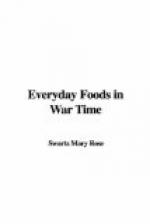In the case of fats, practical economy consists in paying for fuel value and not for flavor. The score values for butter, lard, olive oil, and cottonseed oil are about the same. The cheapest fat is the one whose face value per pound (or market cost) is the lowest. Fats are not as cheap as milk and cereals if they cost over ten cents per pound. The best way to economize is by saving the fat bought with meat, using other fats without much flavor, and cutting the total fat in the diet to a very small amount, not over two ounces per person per day. This is also good food conservation, since fats are almost invaluable in rationing an army, and those with decidedly agreeable flavor are needed to make a limited diet palatable.
No program either of economy or food conservation can cater to individual likes and dislikes in the same way that an unrestricted choice of food can. If one does not like cereals it is hard to consume them just to save money, especially to the extent of ten to fifteen ounces of grain products in a day. Yet one might as well recognize that in this direction the lowering of the cost of the diet inevitably lies. If one does not like corn, it is hard to substitute corn bread for wheat bread. But one might as well open one’s mind to the fact that the only way to put off the day when there will be no white bread to eat is to begin eating cornmeal now. Most of us want to eat our cake and keep it too—to enjoy our food and not pay for our pleasure; to do our duty towards our country and not feel any personal inconvenience. But the magic table of the fairy tale is not for a nation at war; food is not going to come at the pressing of a button during this conflict. If we are to escape bankruptcy and win the war we must eat to be nourished and not to be entertained.
APPENDIX
SOME WAR TIME RECIPES
The following recipes illustrate some of the practical applications of the principles discussed in the foregoing pages. They have been selected from various publications, a list of which is given below. The numbers following the titles of the recipes correspond with the numbers of the publications in this list.
1. Canned Salmon: Cheaper than Meats and Why, U.S. Department of Commerce, Bureau of Fisheries, Economic Circular No. 11
2. Cheese and its Economical Use in the Home, U.S. Department of Agriculture, Farmers’ Bulletin No. 487
3. Economical Diet and Cookery in Time of Emergency, Teachers College, Columbia University, Technical Education Bulletin No. 30 4. Food, Bulletin of the Life Extension Institute, 25 West 45th Street, New York City
5. Honey and its Uses in the Home, U. S. Department of Agriculture, Farmers’ Bulletin No. 653
6. How to Select Food: Foods Rich in Protein, U.S. Department of Agriculture, Farmers’ Bulletin No. 824
7. Meat Substitutes, Connecticut Agricultural College, Emergency Food Series, No. 10




